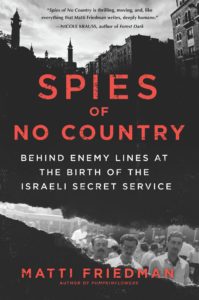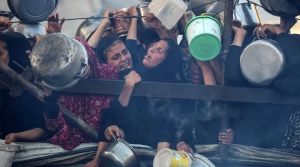Kol ha-kavod” (congratulations) to Israeli writer Matti Friedman, whose latest non-fiction book, Spies of No Country, seems destined for the sort of acclaim won by his two previous, prize-winning titles: The Aleppo Codex (2014) and Pumpkinflowers (2016). Readers of this newspaper may take special pride in Friedman because he grew up in Toronto.

Spies of No Country tells the story of four young men who served heroically, and at great personal risk, as spies during the Israeli War of Independence (1947 to 1949). Intensely loyal Zionists of swarthy appearance, they were chosen because they could easily pass as Arabs without raising too many eyebrows. As Jews from Arab lands, Arabic was their first language and they were deeply familiar with the ways, customs, idioms and social habits of Arab society. But, of course, they couldn’t know everything, and sometimes, while inwardly panicking, they had to bluff their way through prayer rituals and the like.
The unit, known as the Arab Section, consisted of Gamliel Cohen, born in Syria; Isaac Shoshan (from Aleppo); Havakuk Cohen (Yemen); and Yakuba Cohen (British-Mandate Jerusalem). They did not call themselves “agents” or “spies,” instead preferring the unusual Hebrew and Arabic word “mista’arvim,” which translates as “Ones Who Become Like Arabs.”
They were the eyes and ears of Jewish intelligence within the Arab areas of Haifa, Jaffa and other areas of pre-state Israel as well as Beirut, Damascus and Aleppo. Besides reporting back on the increasingly belligerent and bloodthirsty mood of the local populace, they indulged in frequent “black ops” exploits requiring huge amounts of bravado, nerve and spontaneity under pressure.
Once, they discovered a plot in Haifa to paint a car as a British ambulance, so it could be used to blow up a cinema house. One of the spies drove a car rigged with a bomb past several checkpoints into the Arab sector, entered a garage on Nazareth Street, and parked beside the fake ambulance. As their getaway car raced from the scene, an explosion rocked the air. “People watching from points higher up the slopes of Mount Carmel thought it looked like an atom bomb going off in the lower city. In the moments of eerie silence that follow a blast that size, the two agents watched the black cloud rise and recede in the rear-view mirror.”
Amidst the increasing turmoil in the region, as Arab residents evacuated Palestine and native Jews escaped their Arab homelands, the isolated group of ragtag operatives conducted intel operations as well as assassinations and other attacks. They communicated with their handlers back home by means of secret radio transmissions from antennas often disguised as clotheslines. All the while they walked a tightrope in their secret identities, constantly worried about discovery at a time when both Jews and Arabs suspected spies beneath every rock.
Once one of the mista’arvim, passing as a working-class Palestinian Muslim, brought suspicion upon himself by using toilet paper in a privy, a habit that was decidedly Western and middle-class; poorer folks, apparently, just used water.
Friedman interviewed Isaac Shoshan, one of the principal actors in this little-known drama, who had an excellent memory for a man of 93. The author spoke with many peripheral figures and also plumbed Israel’s military archives, published histories, newspapers and private papers for details of the story, which unfolds like some of the best works of Erik Larson (Devil in the White City, In the Garden of Beasts).
The way Friedman embeds so many photographs into the narrative also reminded me of the non-fiction book Time and Again by the late, great American author Jack Finney.
READ: MATTI FRIEDMAN CONVERSES WITH AN OLD SPY
In lesser hands, this story might not be capable of sustaining the interest of readers through more than 200 pages, but Friedman is a natural-born storyteller whose simple but compelling language, and level of insight and sensitivity, seem to anticipate and settle questions in the readers’ minds even before they arise. Early on, he offers this intelligent assessment of the story’s significance:
“The unwritten rules of espionage writing seem to require a claim that the subjects altered the very course of history, or at least of their war,” he writes. “This is tempting but rarely true, I suspect, and it isn’t true in the case of our spies, though their contribution to the war was significant. Their mission didn’t culminate in a dramatic explosion that averted disaster, or in the solution of a devious puzzle. Their importance to history lies instead in what they turned out to be – the embryo of one of the world’s most formidable intelligence services [the Mossad] . . . .”
While men on longterm missions behind enemy lines might willingly risk their lives, they are generally less willing to forgo female companionship. Within the annals of Israeli espionage are stories of deeply-placed Jewish agents who married local women as part of their cover, Friedman reports. “One of them, a Jew from Iraq, had a child with a Muslim woman who was unaware of his real identity, while at the same time his real wife and children lived in a Jewish town not far away. When he was extracted after years in the field, he had to abandon his Arab family.”
Such tales put the stamp of truth upon the epigraph by William Boyd that Friedman has posted at the front of the book: “The tropes of espionage – duplicity, betrayal, disguise, clandestinity, secret knowledge, the bluff, the double bluff, unknowingness, bafflement, shifting identity – are no more than the tropes of the life that every human being lives.”
* * *
The Rag Race: How Jews Sewed Their Way to Success in America and the British Empire, by Adam D Mendelsohn
(New York University Press)
Jews rode upon the coattails of the so-called “shmattah” trade “from the margins of economic life to a position of unusual promise and prominence,” Mendelsohn writes in this thorough academic exploration of the needle trade on both sides of the Atlantic. An American scholar, he stitches together a compelling discussion about the phenomenal rise of many Jewish immigrants from sweatshop labourers to factory owners and garment-industry moguls.






